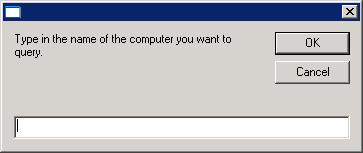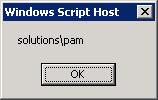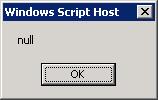Who is Logged On to a Computer - VBS Script
If you need to know whether anyone is logged into a remote computer
in your domain or who that might be, you can use
LoggedOn.vbs,
a script I found at
List User Logged On To A Remote Computer, which was written by
Cheyenne Harden and is available at the
LazyNetworkAdmin.Com website
or from this site (see links below).
To use the utility, you can enter LoggedOn.vbs
at the command line while in the directory where the file
is located. A small window will open prompting you for the name
of the computer to query.

You will see the logged on user displayed in a small Windows
Script Host window as shown below:

If no one is logged on to the system, you will see "null" displayed
in the small Windows Script Host window that opens.

If you want the logged on user information displayed in a form
that you can copy and paste into a document, you can use
cscript /nologo LoggedOn instead. The results will
then be displayed on the command line as below:
C:\Program Files\Utilities\Miscellaneous>cscript /nologo LoggedOn.vbs
solutions\pam
If no one is logged into the system, you will see "null" displayed
on the command line.
C:\Program Files\Utilities\Miscellaneous>cscript /nologo LoggedOn.vbs
null
If the system can't be queried, you won't see an error message.
Instead, you won't see anything displayed.
Information on other utilities to display the logged on user can
be found at Who Is
Logged On?.
LoggedOn.vbs
LoggedOn.zip
References:
-
List User Logged On To A Remote Computer
By Cheyenne Harden
LazyNetworkAdmin.com
-
Who Is Logged On?
MoonPoint Support
[/languages/vbs/sysadmin]
permanent link
Creating an Alias Email Address on Exchange 2003 Server
You can create an alias on a Microsoft Exchange server so that an
account can receive email for multiple email addresses. E.g., suppose
John Smith in the sales department has an account in the domain with
a userid of John. He would like to receive email whether it is addressed
to john@example.com, jsmith@example.com, or sales@example.com. Perhaps
there are several people who need to receive any email addressed to
sales@example.com. You can attach an alias to an individual user account
or you can set up a new group on the server and include all of the
relevant user accounts in the group, so that they all get email
addressed to the group name.
[ More Info ]
[/network/email/exchange]
permanent link
Bazooka Update Failure
When attempting to update the malware database for
Bazooka ™ Adware and Spyware Scanner,
a free tool for detecting adware, spyware, trojans, keyloggers, etc. on a
system, which is compatible with Windows 95/98/ME/NT/2000/XP, I received the
message below:
Error updating database. Could not save the new database on the hard drive.
An error occurred when trying to open the file for writing.
Filename: 'system\bazooka_db.bdb'
Current Working Directory: C:\Program Files\Security\Spyware\Bazooka Scanner\
System error message: Access is denied.
C++ exception: ios::failbit set
Could not update the database. Please check the following:
1. Are you connected to the Internet?
2. Maybe it was a temporary error. Please try again later.
You can also update the database manually. Would you like to have instructions
how to update it manually?
When I checked the properties of the Bazooka database,
bazooka_db.bdb, which is under the system directory
of the Bazooka installation folder, by right-clicking on the file and
selecting Properties, I found it was marked as "read-only".
I unchecked the read-only option and then was able to update the database.
[/security/spyware/bazooka]
permanent link




